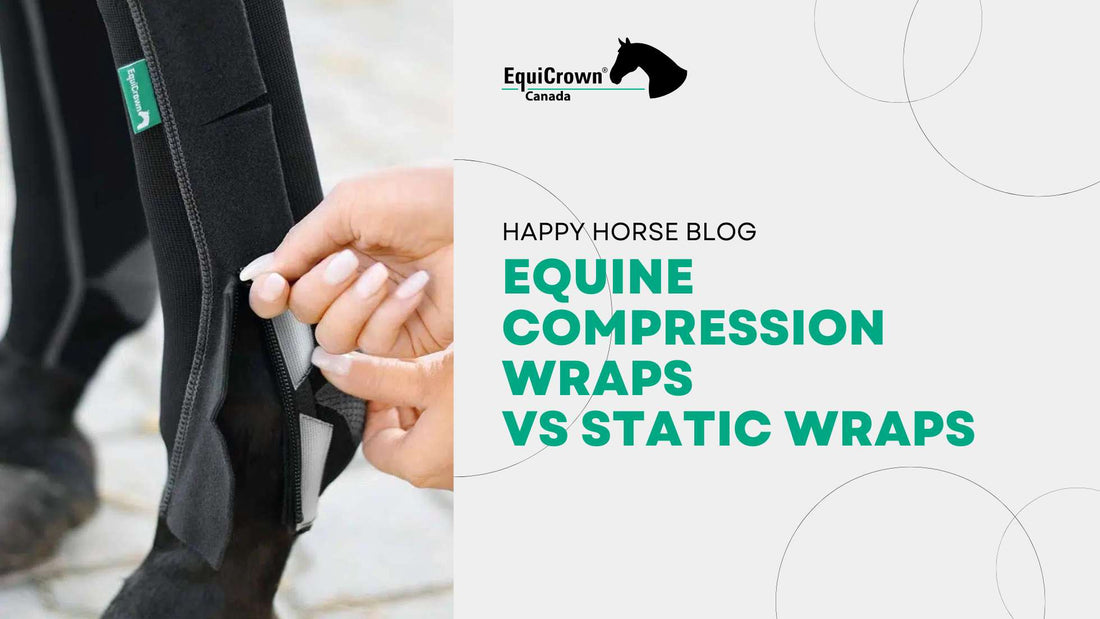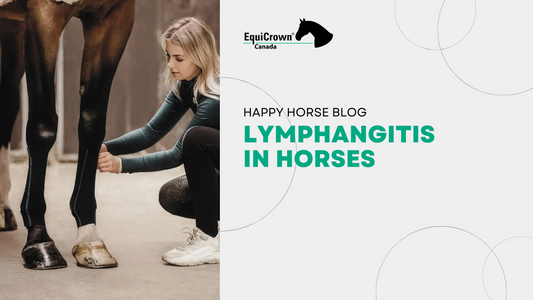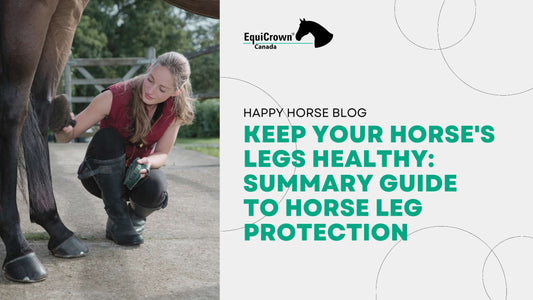
Equine Compression Wraps VS Static Wraps
COMPRESSION WRAPS VS STATIC WRAPS
Compression therapy has a rich history dating back to human medicine around 400 BC. Over the past century, physicians have used graduated compression stockings to enhance venous return, circulation, and recovery time from injuries. The benefits of compression therapy have not been limited to humans, as sports scientists have found similar positive effects on athletes who wear graduated compression garments during and after intense activity. The benefits include increased oxygen availability to muscles, significantly reduced lactic acid production, enhanced recovery time from injury, and reduced delayed onset muscle soreness (DOMS) and swelling associated with exercise. Furthermore, compression garments have been shown to aid the body in expelling waste products, such as lactic acids and carbon dioxide, after exercise.
FROM HUMANS TO HORSES
Recently, the use of compression wraps for horses has gained popularity, with much of the technology and experience borrowed from human medicine. Horses, particularly those in hot, humid climates, face significant risk to their delicate legs due to strenuous conditioning and training. Traditional solutions such as quilts and polos can trap heat around the leg, potentially ending a horse’s career in a worst-case scenario.
The challenges don't stop there. Horses stabled with minimal time for free movement, in addition to concentrated physical training, face an unnatural movement routine. The transport capacity of the lymphatic system decreases significantly when a horse is standing in a confined space, such as a stall, small paddock, or trailer. This reduction in flow velocity and total volume of lymph fluid puts the standing horse at a disadvantage in terms of recovery from injury or exertion.
Horses have roughly 8,000 lymph nodes, compared to an average of 500 in humans. This leads to a greater propensity for lymphatic "bottlenecks", where the lymphatic fluid slows down and concentrates when entering each lymph node. Consequently, performance horses frequently develop swollen or filled legs due to lymphatic compromise. Graduated compression acts like a mechanical massage on the leg, stimulating circulation and keeping the leg tight and cool.
Rethinking the Prevention of "Stocking Up"
The use of standing wraps has traditionally been the accepted method to counteract "stocking up". However, recent research by lymph specialist Dirk Berens von Rautenfeld from the Medical University of Hannover questions this practice. According to von Rautenfeld, "Bandages are poison for the lymphatic and blood flow once the horse is not moving". The issue becomes critical when the head of the fetlock is bandaged as it already has a natural bottleneck, and the bandage further restricts the transport systems.
Every horse has a relatively weak pumping system serving the vascular walls. When standing idle in a stall, there is insufficient absorption and subsequent evacuation of watery lymphatic fluids by the venous capillaries and lymphatic stream. As these fluids follow gravity, they tend to pool at the lowest points of the horse’s body—the legs.
Von Rautenfeld suggests movement as the best and most economical solution, which enables the vascular musculature to pump the lymphatic fluids up into the chest cavity and gut for elimination. As a preventative measure, he recommends the use of equine compression wraps for half the day or when stalled, and advises that the horses be allowed to move freely in a reasonably sized pasture for the remainder of the day.

STATIC VERSUS COMPRESSION WRAP
One study compared traditional bandaging material with elastic compression garments on lymph flow in a horse’s legs. Ten horses with a tendency for stocking up were examined under sedation with lymphangiography. A continuous subdermal injection of X-ray contrast fluid was put through the lymph vessels of the horses’ legs. The fluid movement was seen to stop with the use of traditional standing wraps, but maintained normal flow with the elastic compression garments.
Wraps provide graduated compression from under the fetlock and up the cannon. When a horse is sized correctly, the wrap should fit like a second skin, exerting “mechanical pressure” on the skin surface, stimulating rather than constricting circulation. The fabric used in these garments is woven specifically for vascular support.
Compression wraps also manage conditions like lymphangitis or severe wounds.
What if the horse has sustained a horrific injury or developed lymphangitis? Compression therapy for your equine buddy needs to be as individualized for him as it would be for yourself. Sizing, service, and product quality are keys to making compression therapy work for your horse. Always discuss the use of compression wraps with your veterinarian or therapist prior to application.
Best Practical Applications for Compression Wraps.
Resources
- Alternative Action Treating Lymphangitis, HolisticHorse.com
- Equine Compression Stockings, Gentle Touch Massage & Holistic Alternatives, LLC
- History, Hidez Science, hidez.com
- Compression Bandaging to Manage Edema, Mimi Porter, HolisticHorse.com
OU1 Wikipedia, https://en.wikipedia.org/wiki/Compression_stockings#History
OU2 Human Kinetics, Compression garments may be beneficial to recovery process, excerpt from Recovery for Performan in Sport edited by INSEP (https://en.wikipedia.org/wiki/INSEP) (http://www.humankinetics.com/excerpts/excerpts/compression-garments-may-be-beneficial-to-recovery-process
OU3 Equine MLD, Heather Powell, http://equinemld.com/research-articles/
Combined decongestive therapy including equine manual lymph drainage to assist management of chronic progressive lymphoedema in draft horses. H. Powell,Equine MLD, Worcestershire, UK; V.K. Affolter, UC Davis, School of Veterinary Medicine, Pathology, Microbiology, Immunology, Davis, USA
Bloodstock, Equine Health, July/August 2012 – The importance of the lymphatic system.
OU4 Term “Stocking up” is accepted colloquial expression among equine enthusiasts and veterinary medicine/von Hauff.
Equine Compression Stockings, Gentle Touch Massage & Holistic Alternatives, LLC www.gentletouchmassage.net,
http://www.ml-pferd.de/&prev=search
OU5 http://www.ml-pferd.de/&prev=search Equine Compression Stockings, Gentle Touch Massage & Holistic Alternatives, LLC
OU6 http://www.ml-pferd.de/&prev=search
Equine Compression Stockings, Gentle Touch Massage & Holistic Alternatives, LLC
OU7 Holistic Horse, From Humans to Horses, Mimi Porter
Bloodstock, Equine Health, July/August 2012 – The importance of the lymphatic system
Donna von Hauff is a founder of Strathcona Ventures, the managing company for EquiCrown Canada. She is also a member of the Practice Review Board for the Alberta Veterinary Medical Association. Her career history spans serving as Vice President of Concordia University of Edmonton 1996-2006, working as a consultant to the Alberta government and industry 1985 – 1997, and an author/editor of magazine and scholarly articles, and four books. Early retirement provided Donna with the opportunity to further develop her knowledge and work with horses and their owners/riders/trainers.
www.EquiCrownCanada.com




